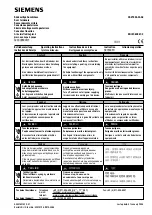
2
1.
POWER REQUIREMENTS
:
Must use Class 2 or SELV rated power supply.
Power connection via removable three position terminal block.
Supply Voltage:
+24 VDC ±20%
Typical Power
1
:
27 W
Maximum Power
2
:
67 W
Notes:
1. Typical power with +24 VDC, RS232/485 communications, Ethernet
communications, CompactFlash card installed, and display at full brightness.
2. Maximum power indicates the most power that can be drawn from the
315. Refer to “Power Supply Requirements” under “Installing and
Powering the 315.”
3. The 315’s circuit common is not connected to the enclosure of the unit.
See “Connecting to Earth Ground” in the section “Installing and
Powering the 315.”
4. Read “Power Supply Requirements” in the section “Installing and
Powering the 315” for additional power supply information.
2.
BATTERY
: Lithium coin cell. Typical lifetime of 10 years.
3.
LCD DISPLAY
:
*Lifetime at room temperature. Refer to “Display” in “Software/Unit Operation”
4.
10-KEY KEYPAD
: for on-screen menus.
5.
TOUCHSCREEN
: Resistive analog
6.
MEMORY
:
On Board User Memory
: 32 Mbyte of non-volatile Flash memory.
Memory Card
: CompactFlash Type II slot for Type I and Type II
CompactFlash cards.
7.
COMMUNICATIONS
:
USB Device Port
: Adheres to USB 2.0 Specification supporting high speed
and full speed via Type B connection.
Serial Ports
: Format and Baud Rates for each port are individually software
programmable up to 115,200 baud.
PGM Port: RS232 port via RJ12.
COMMS Ports: RS422/485 port via RJ45, and RS232 port via RJ12.
DH485 TXEN: Transmit enable; open collector, V
OH
= 15 VDC,
V
OL
= 0.5 V @ 25 mA max.
Note: For additional information on the communications or signal
common and connections to earth ground please see the “Connecting to
Earth Ground” in the section “Installing and Powering the 315.”
Port to port isolation: 500 Vrms for 1 minutes signal isolation : 50V
Ethernet Port
: 10 BASE-T / 100 BASE-TX
RJ45 jack is wired as a NIC (Network Interface Card).
Isolation from Ethernet network to CTVue operator interface: 1500 Vrms
8.
ENVIRONMENTAL CONDITIONS
:
Operating Temperature Range
: 0 to 50°C
Storage Temperature Range
: -20 to 70°C
Operating and Storage Humidity
: 80% maximum relative humidity (non-
condensing) from 0 to 50°C.
Altitude
: Up to 2000 meters.
9.
CERTIFICATIONS AND COMPLIANCES
:
SAFETY
IEC 61010-1, EN 61010-1: Safety requirements for electrical equipment
for measurement, control, and laboratory use, Part 1.
IP66 Enclosure rating (Face only), IEC 529
Type 4X Enclosure rating (Face only), UL50
ELECTROMAGNETIC COMPATIBILITY
Emissions and Immunity to EN 61326: Electrical Equipment for
Measurement, Control and Laboratory use.
Note:
1. Criterion A: Normal operation within specified limits.
2. Criterion B: Temporary loss of performance from which the unit self
recovers.
10.
CONNECTIONS
: Compression cage-clamp terminal block.
Wire Gage: 12-22 AWG copper wire
Torque: 5-7 inch-pounds (56-79 N-cm)
11.
CONSTRUCTION
: Steel rear metal enclosure with NEMA 4X/IP66
aluminum front plate for indoor use only when correctly fitted with the gasket
provided. Installation Category II, Pollution Degree 2.
12.
MOUNTING REQUIREMENTS
: Maximum panel thickness is 0.25" (6.3
mm). For NEMA 4X/IP66 sealing, a steel panel with a minimum thickness of
0.125" (3.17 mm) is recommended.
Maximum Mounting Stud Torque
: 17 inch-pounds (1.92 N-m)
13.
WEIGHT
: 11.41 lbs (5.17 Kg)
DIMENSIONS In inches (mm)
S
PECIFICATIONS
SIZE
15-inch
TYPE
TFT
COLORS
32K
PIXELS
1024 X 768
BRIGHTNESS
600 cd/m
2
BACKLIGHT
*
50,000 HR TYP.
Class A
EN 55011
Emissions
Emissions:
3 V/rms
Criterion B
EN 61000-4-6
RF conducted interference
2 kV L&N-E power
2 kV power
Criterion B
EN 61000-4-4
Fast transients (burst)
Criterion A
EN 61000-4-5
Surge
1 kV L-L,
10 V/m
Criterion B
EN 61000-4-3
Electromagnetic RF fields
1 kV signal
8 kV air discharge
4 kV contact discharge
Criterion A
EN 61000-4-2
Electrostatic discharge
Immunity to Industrial Locations:
WARNING - DO NOT CONNECT OR DISCONNECT CABLES
WHILE POWER IS APPLIED UNLESS AREA IS KNOWN TO BE
NON-HAZARDOUS. USB PORT IS FOR SYSTEM SET-UP AND
DIAGNOSTICS AND IS NOT INTENDED FOR PERMANENT
CONNECTION.
Содержание DRIVE CENTRE 315C
Страница 8: ......


























